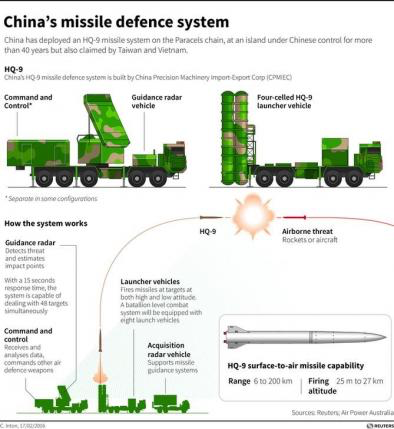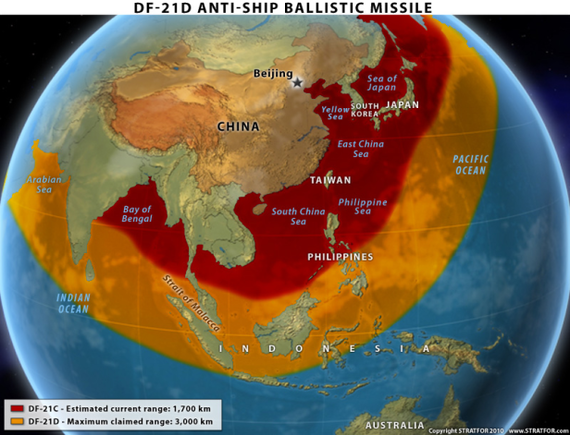The future is here it's just distributed unevenly - Silicon Valley view of tech adoption
The threat is here it's just distributed unevenly - A2/AD and the aircraft carrier
This is the second of a two-part post following my stay on the aircraft carrier USS Carl Vinson. Part 1 talked about what I saw and learned - the layout of a carrier, how the air crew operates and how the carrier functions in context of the other ships around it (the strike group.) But the biggest learning was the realization that disruption is not just happening to companies, it's also happening to the Navy. And that the Lean Innovation tools we've built to deal with disruption and create continuous innovation for large commercial organizations were equally relevant here.
This post offers a few days' worth of thinking about what I saw. (If you haven't, read part 1 first.)
---
The threat is here; it's just distributed unevenly - A2/AD and the aircraft carrier
- The aircraft carrier is viable for another 30 years.
- The aircraft carrier is obsolete.
Well-defended targets
Think of an aircraft carrier as a $11 billion dollar portable air force base manned by 5,000 people delivering 44 F/A-18 strike fighters anywhere in the world.
The primary roles of the 44 F/A-18 strike fighters that form the core of the carrier's air wing is to control the air and drop bombs on enemy targets. For targets over uncontested airspace (Iraq, Afghanistan, Syria, Somalia, Yemen, Libya, etc.) that's pretty easy. The problem is that First World countries have developed formidable surface-to-air missiles - the Russian S-300 and S-400 and the Chinese HQ-9 - which have become extremely effective at shooting down aircraft. And they have been selling these systems to other countries (Iran, Syria, Egypt, etc.). While the role of an aircraft carrier's EA-18G Growlers is to jam/confuse the radar of these missiles, the sophistication and range of these surface-to-air missiles have been evolving faster than the jamming countermeasures on the EA-18G Growlers (and the cyber hacks to shut the radars down).
This means that the odds of a carrier-based F/A-18 strike fighter successfully reaching a target defended by these modern surface-to-air missiles is diminishing yearly. Unless the U.S. military can take these air defense systems out with drones, cruise missiles or cyber attack, brave and skilled pilots may not be enough. Given the F/A-18's are manned aircraft (versus drones), high losses of pilots may be (politically) unacceptable.
Vulnerable carriers
If you want to kill a carrier, first you must find it and then you have to track it. In WWII knowing where the enemy fleet located was a big - and critical - question. Today, photo imaging satellites, satellites that track electronic emissions (radio, radar, etc.) and satellites with synthetic aperture radar that can see through clouds and at night are able to pinpoint the strike group and carrier 24/7. In the 20th century only the Soviet Union had this capability. Today, China can do this in the Pacific and to a limited extent, Iran has this capability in the Persian Gulf. Soon there will be enough commercial satellite coverage of the Earth using the same sensors, that virtually anyone able to pay for the data will be able to track the ships.
During the Cold War the primary threat to carriers was from the air - from strike/fighters dropping bombs/torpedoes or from cruise missiles (launched from ships and planes). While the Soviets had attack submarines, our anti-Submarine Warfare (ASW) capabilities (along with very noisy Soviet subs pre-Walker spy ring) made subs a secondary threat to carriers.
In the 20th century the war plan for a carrier strike group used its fighter and attack aircraft and Tomahawk cruise missiles launched from the cruisers to destroy enemy radar, surface-to-air missiles, aircraft and communications (including satellite downlinks). As those threats are eliminated, the carrier strike can move closer to land without fear of attack. This allowed the attack aircraft to loiter longer over targets or extend their reach over enemy territory.
Carriers were designed to be most effective launching a high number of sorties (number of flights) from ~225 miles from the target. For example, we can cruise offshore of potential adversaries (Iraq and Syria) who can't get to our carriers. (Carriers can standoff farther or can reach further inland, but they have to launch F-18's as refueling tankers to extend the mission range. For example, missions into Afghanistan are 6-8 hours versus normal mission times of 2-3 hours.)
In the 21st century carrier strike groups are confronting better equipped adversaries, and today carriers face multiple threats before they can launch an initial strike. These threats include much quieter submarines, long-range, sea-skimming cruise missiles, and in the Pacific, a potential disruptive game changer - ballistic missiles armed with non-nuclear maneuverable warheads that can hit a carrier deck as it maneuvers at speed (DF-21d and the longer range DF-26).
In the Persian Gulf the carriers face another threat - Fast Inshore Attack Craft (FIAC) and speedboats with anti-ship cruise missiles that can be launched from shore.
The sum of all these threats - to the carrier-based aircraft and the carriers themselves - are called anti-access/area denial (A2/AD) capabilities.
Eventually the cost and probability of defending the carrier as a manned aircraft platform becomes untenable in highly defended A2/AD environments like the western Pacific or the Persian Gulf. (This seems to be exactly the problem the manned bomber folks are facing in multiple regions.) But if not a carrier, what will they use to project power? While the carrier might become obsolete, the mission certainly has not.
So how does/should the Navy solve these problems?
Three Horizons of Innovation
- Horizon 1 activities support executing the existing mission with ever increasing efficiency
- Horizon 2 is focused on extending the core mission
- Horizon 3 is focused on searching for and creating brand new missions (see here for background on the Three Horizons.)
Horizon 1 is the Navy's core mission. Here the Navy executes against a set of known mission requirements (known beneficiaries, known ships and planes, known adversaries, deployment, supply chain, etc.) It uses existing capabilities and has comparatively low risk to get the next improvement out the door.
In a well-run organization like the Navy, innovation and improvement occurs continuously in Horizon 1. Branches of the Navy innovate on new equipment, new tactics, new procurement processes, more sorties on newer carriers, etc. As fighter pilots want more capable manned aircraft and carrier captains want better carriers, it's not a surprise that Horizon 1 innovations are upgrades - the next generation of carriers - Ford Class; and next generation of navy aircraft - the F-35C. As a failure here can impact the Navy's current mission, Horizon 1 uses traditional product management tools to minimize risk and assure execution. (And yes, like any complex project they still manage to be over budget and miss their delivery schedule.)
Because failure here is unacceptable, Navy Horizon 1 programs and people are managed by building repeatable and scalable processes, procedures, incentives and promotions to execute and the mission.
In Horizon 2, the Navy extends its core mission. Here it looks for new opportunities within its existing mission (trying new technology on the same platform, using the same technology with new missions, etc.) Horizon 2 uses mostly existing capabilities (the carrier as an aircraft platform, aircraft to deliver munitions) and has moderate risk in building or securing new capabilities to get the product out the door.
An example of potential Naval Horizon 2 innovations is unmanned drones flying off carriers to do the jobs fighter pilots hate such as serving as airborne tankers (who wants to fly a gas tank around for 6 hours?) and ISR (Intelligence, Surveillance and Reconnaissance), another tedious mission flying around for hours that could be better solved with a drone downlinking ISR data for processing on board a ship.
However, getting the tanker and ISR functions onto drones only delays the inevitable shift to drones for strike, and then for fighters. The problem of strike fighters' increasing difficulty in penetrating heavily defended targets isn't going to get better with the new F-35C (the replacement for the F/A-18). In fact, it will get worse. Regardless of the bravery and skill of the pilots, they will face air defense systems evolving at a faster rate than the defensive systems on the aircraft. It's not at all clear in a low-intensity conflict (think Bosnia or Syria) that civilian leadership will want to risk captured or killed pilots and losing planes like the F-35C that cost several hundred million dollars each.
Management in Horizon 2 works by pattern recognition and experimentation inside the current mission model. Ironically, institutional inertia keeps the Navy from deploying unmanned assets on carriers. In a perfect world, drones in carrier tanker and ISR roles should have been deployed by the beginning of this decade. And by now experience with them on a carrier deck could have led to first, autonomous wingmen and eventually autonomous missions. Instead the system appears to have fallen into the "real men fly planes and command Air Wings and get promoted by others who do" mindset.
The Navy does not lack drone demos and prototypes, but it has failed to deploy Horizon 2 innovations with speed and urgency. Failure to act aggressively here will impact the Navy's ability to carry out its mission of sea control and power projection. (The Hudson Institute report on the future of the carrier is worth a read, and a RAND report on the same topic comes out in October.)
If you think Horizon 2 innovation is hard in the Navy, wait until you get to Horizon 3. This is where disruption happens. It's how the aircraft carrier disrupted the battleship. How nuclear-powered ballistic missile submarines changed the nature of strategic deterrence, and how the DF-21/26 and artificial islands in the South China sea changed decades of assumptions. And it's why, in most organizations, innovation dies.
For the Navy, a Horizon 3 conversation would not be about better carriers and aircraft. Instead it would focus on the core reasons the Navy deploys a carrier strike group: to show the flag for deterrence, or to control part of the sea to protect shipping, or to protect a Marine amphibious force, or to project offensive power against any adversary in well-defended areas.
A Horizon 3 solution for the Navy would start with basic need of these missions (sea control, offensive power projection - sortie generation) the logistic requirements that come with them, and the barriers to their success like A2/AD threats. Lots of people have been talking and writing about this and lots of Horizon 3 concepts have been proposed such as Distributed Lethality, Arsenal Ships, underwater drone platforms, etc.
Focusing on these goals - not building or commanding carriers, or building and flying planes - is really, really hard. It's hard to get existing operational organizations to think about disruption because it means they have to be thinking about obsoleting a job, function or skill they've spent their lives perfecting. It's hard because any large organization is led by people who succeeded as Horizon 1 and 2 managers and operators (not researchers). Their whole focus, career, incentives, etc. has been about building and make the current platforms work. And the Navy has excelled in doing so.
The problem is that Horizon 3 solutions take different people, different portfolio, different process and different politics.
People: In Horizon 1 and 2 programs people who fail don't get promoted because in a known process failure to execute is a failure of individual performance. However, applying the same rules to Horizon 3 programs - no failures tolerated - means we'll have no learning and no disruptive innovations. What spooks leadership is that in Horizon 3 most of the projects will fail. But using Lean Innovation they'll fail quickly and cheaply.
In Horizon 3 the initial program is run by mavericks - the crazy innovators. In the Navy, these are the people you want to court martial or pass over for promotion for not getting with current program. (In a startup they'd be the founding CEO.) These are the fearless innovators you want to create new and potentially disruptive mission models. Failure to support their potential disruptive talent means it will go elsewhere.
Portfolio: In Horizon 3, the Navy is essentially incubating a startup. And not just one. The Navy needs a portfolio of Horizon 3 bets, for the same reason venture capital and large companies have a portfolio of Horizon 3 bets - most of these bets will fail - but the ones that succeed are game changers.
Process: A critical difference between a Horizon 3 bet and a Horizon 1 or 2 bet is that you don't build large, expensive, multi-year programs to test radically new concepts (think of the Zumwalt class destroyers). You use "Lean" techniques to build Minimal Viable Products (MVPs). MVPs are whatever it takes to get you the most learning in the shortest period of time.
Horizon 3 groups operate with speed and urgency - the goal is rapid learning. They need to be physically separate from operating divisions in an incubator, or their own facility. And they need their own plans, procedures, policies, incentives and Key Performance Indicators (KPIs) different from those in Horizon 1.
The watchwords in Horizon 3 are "If everything seems under control, you're just not going fast enough."
Politics: In Silicon Valley most startups fail. That's why we invest in a portfolio of new ideas, not just one. We embrace failure as an integral part of learning. We do so by realizing that in Horizon 3 we are testing hypotheses - a series of unknowns - not executing knowns. Yet failure/learning is a dirty word in the world of promotions and the "gotcha game" of politics. To survive in this environment Horizon 3 leaders must learn how to communicate up/down and sideways that they are not running Horizon 1 and 2 projects.
Meanwhile, Navy and DOD leadership has to invest in, and clearly communicate their innovation strategy across all three Horizons.
Failure to manage innovation across all three Horizons and failure to make a portfolio of Horizon 3 bets means that the Navy is exposed to disruption by new entrants. Entrants unencumbered by decades of success, fueled by their own version of manifest destiny.
Lessons Learned
- Threats that can degrade or negate a carrier strike group exist in multiple areas
- However, carriers are still a significant asset in almost all other combat scenarios
-- Speed and urgency rather than institutional inertia should be the watchwords for Horizon 2 innovation
- It's what Silicon Valley calls disruption
- It requires different people, portfolio, process and politics
- Allocating dollars and resources for each
-- Remembering that todays Horizon 3 crazy idea is tomorrow Horizon 1 platform
Thanks to the crew of the U.S.S. Vinson, and Commander Todd Cimicata and Stanford for a real education about the Navy.
Steve Blank's blog: www.steveblank.com


